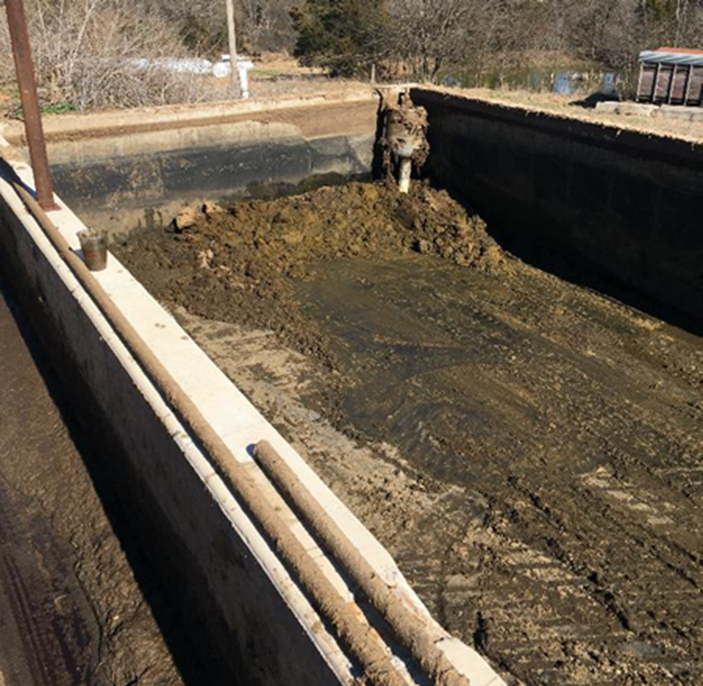Purpose
Many small and mid-sized dairy farms use flush systems for manure removal due to reduced chore time and increased barn cleanliness. Often, flush systems require greater attention to onsite water management and frequent lagoon maintenance. While anaerobic lagoons provide some digestion of manure solids and sludge storage, solids removal may help increase lagoon capacity and reduce costly lagoon sludge removal. A pull-plug sedimentation basin (PPSB) is a passive solids removal system that can reduce the operational time and cost of the overall manure management system by acting as both a sedimentation basin and pre-lagoon solids filter system.
Larger, denser particles accumulate on the basin floor, while buoyant particles (e.g., undigested fiber, waste forage, bedding, etc.) form a floating mat on the surface. The mat acts as a natural filter and retains some of the solids from the waste stream. The PPSB was developed as part of a collaborative effort between USDA NRCS and small dairy producers in Missouri. This abstract provides background and basic information on the PPSB, while more performance evaluation of the system based on nutrient retention, costs, and maintenance and operational considerations can be found in a University of Missouri Extension publication Eq302 (Canter et al., 2021).
What Did We Do?
Design details of a working PPSB were documented, and performance evaluation was conducted based on grab samples of the flush and PPSB locations. Critical design considerations for the PPSB including design, hydraulic loading, location of the pull-plug location, and construction details were reported in the Extension publication (Canter et al., 2021). The concrete entry ramp into the PPSB should have a maximum slope of 12:1 (or 5 degrees) (Figure 1) to minimize wheel slippage and potential for equipment overturns. The example provided in Figure 1 is of a typical PPSB design that serves a herd of ~150 milking cows with a single-flush volume of ~7,000 gallons but also represents the smallest recommended size of the system. A minimum depth of 6 feet is needed to keep settling solids out of the discharge stream.

Detailed discussion of the advantages and disadvantages of the PPSB system was reported in the Extension publication. Relatively little maintenance has been reported, while the pull-plug is the only moving part and may need to be replaced if damaged during cleaning or degradation, Figures 2 and 3. Details such as the management and sampling and analysis were discussed, and a case study was conducted to document the information of a PPSB system of a 120-hd dairy farm in Missouri, with a flush system and sand lane, as well as a performance evaluation.


What Have We Learned?
The owners are satisfied with the performance of the PPSB, which is considered a low-maintenance, low-technology option to efficiently manage manure solids within a flush system. The primary benefit of the PPSB is a reduction in time spent agitating and removing solids/sludge in the lagoon. When less capacity in the lagoon is used for solids treatment and storage, there is more room to store water and longer intervals between repairing or unclogging pumps and the water system. There are typically three to four clean-out periods per year, depending on PPSB and herd sizes and other factors.
The primary benefit of the PPSB is the removal of manure solids using a low maintenance system, resulting in longer intervals between lagoon agitation and land applications. Approximately 23,450 cubic feet of manure solids were prevented from entering the lagoon each year, along with 6,454 pounds of nitrogen (438 pounds as ammonia-nitrogen) and 2,415 pounds of phosphorous. These represent 13 percent and 28 percent of manure-based nitrogen and phosphorous, respectively, being retained in the PPSB.
Future Plans
Additional sampling just before or during clean-out is necessary for a more accurate performance determination. PPSB installed at larger dairy farms, and those using different bedding should be evaluated for performance and documented the cost savings as compared with other popular solid separation systems.
Authors
Teng Lim, Extension Professor, Agricultural Systems Technology, University of Missouri
Corresponding author email address
Limt@missouri.edu
Additional authors
Timothy Canter, Extension Specialist, Agricultural Systems Technology, University of Missouri
Troy Chockley, Environmental Engineer, Natural Resource Conservation Service, United States Department of Agriculture
Additional Information
Canter, T., T.-T. Lim, and T. Chockley. 2021. Considerations of pull-plug sedimentation basin for dairy manure management. University of Missouri Extension. https://extension.missouri.edu/eq302
Acknowledgements
USDA NIFA, Water for Food Production Systems Program A9101, for supporting the project. It is titled “Management of Nutrients for Reuse”, a multi-faceted project that involves professionals from the University of Arkansas, University of Nebraska, Colorado School of Mines and Metallurgy, Case Western University, and University of Missouri.
Joseph Zulovich, Agricultural Systems Technology, University of Missouri
Richard Stowell, Biological Systems Engineering, University of Nebraska

